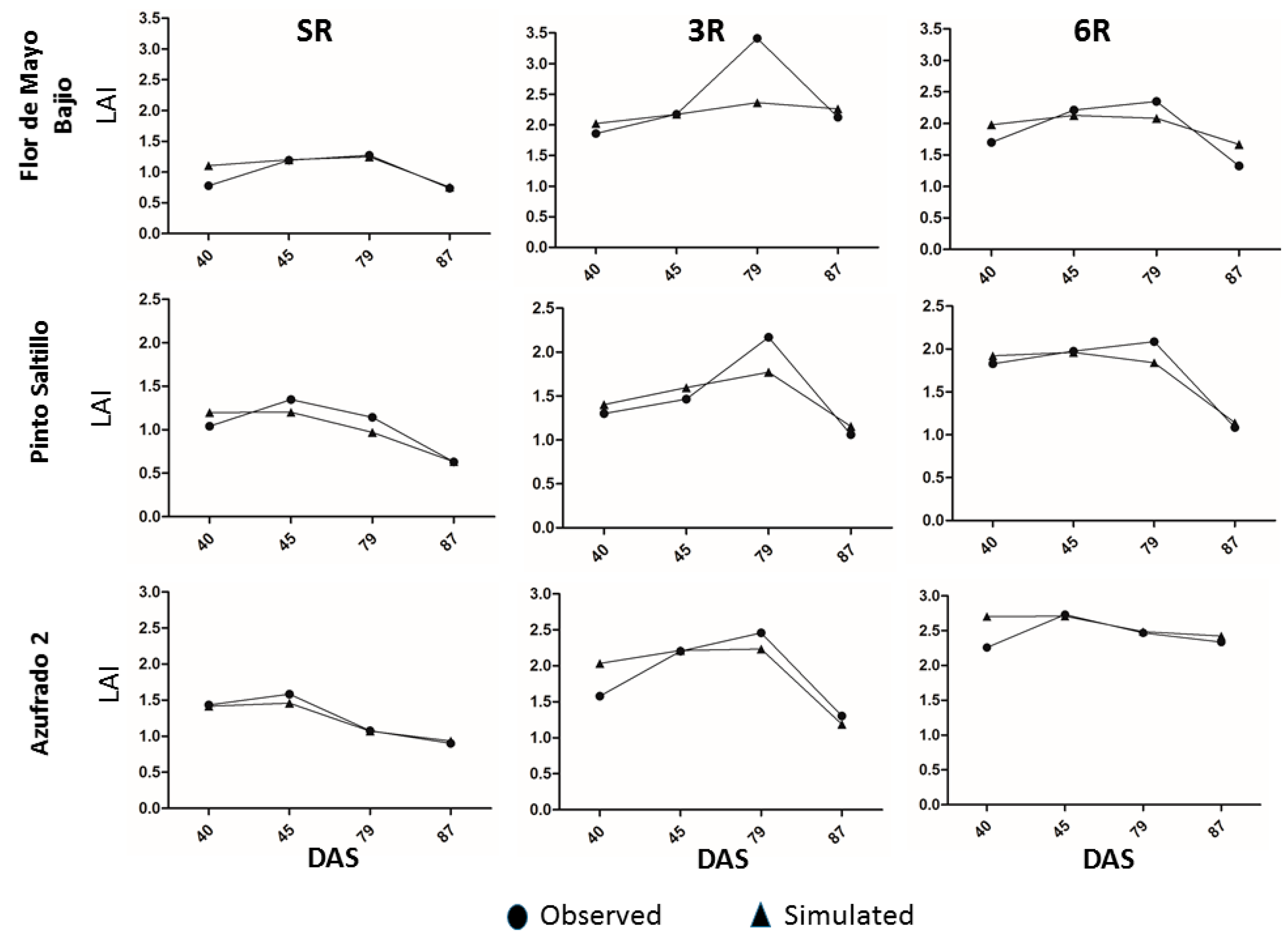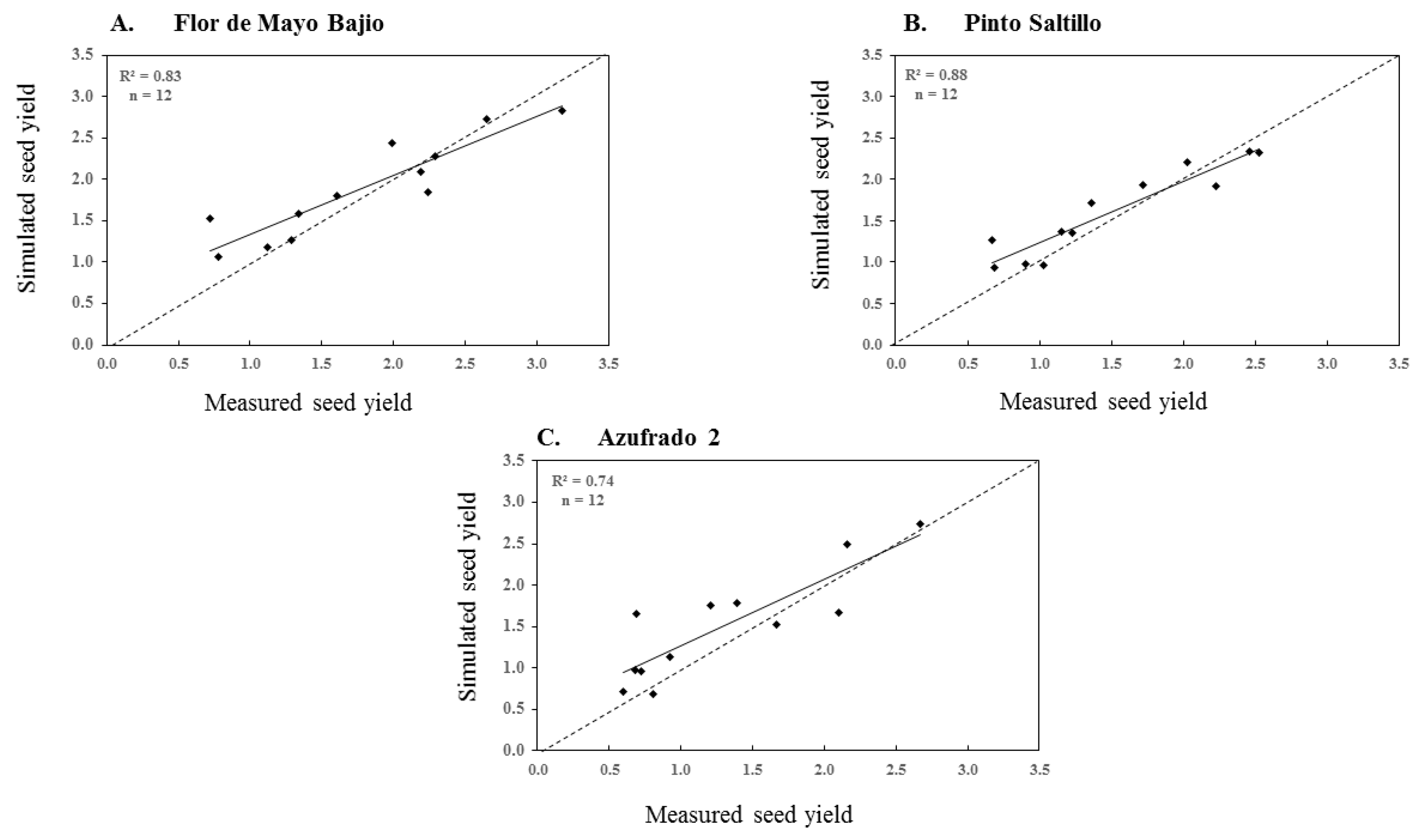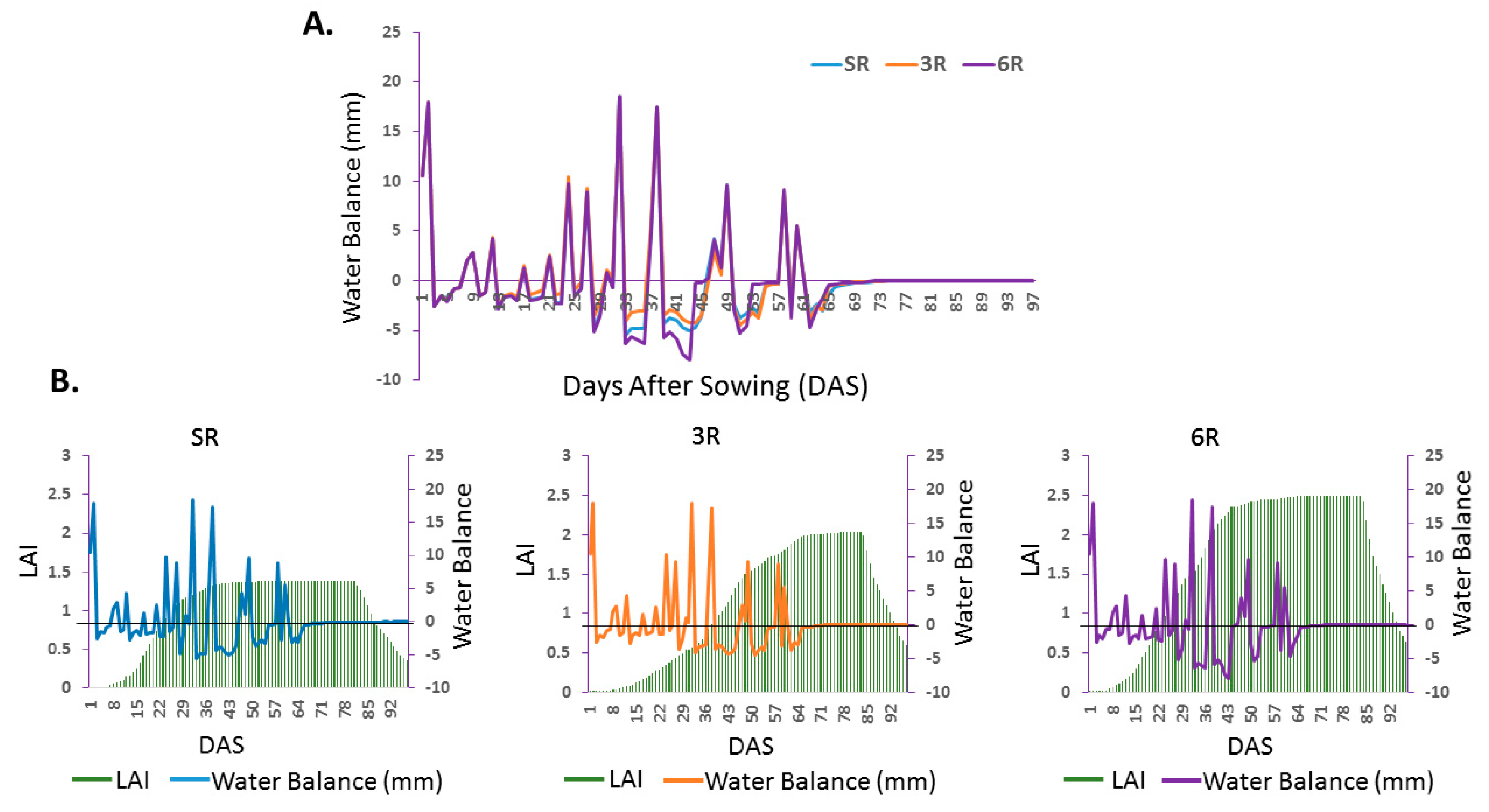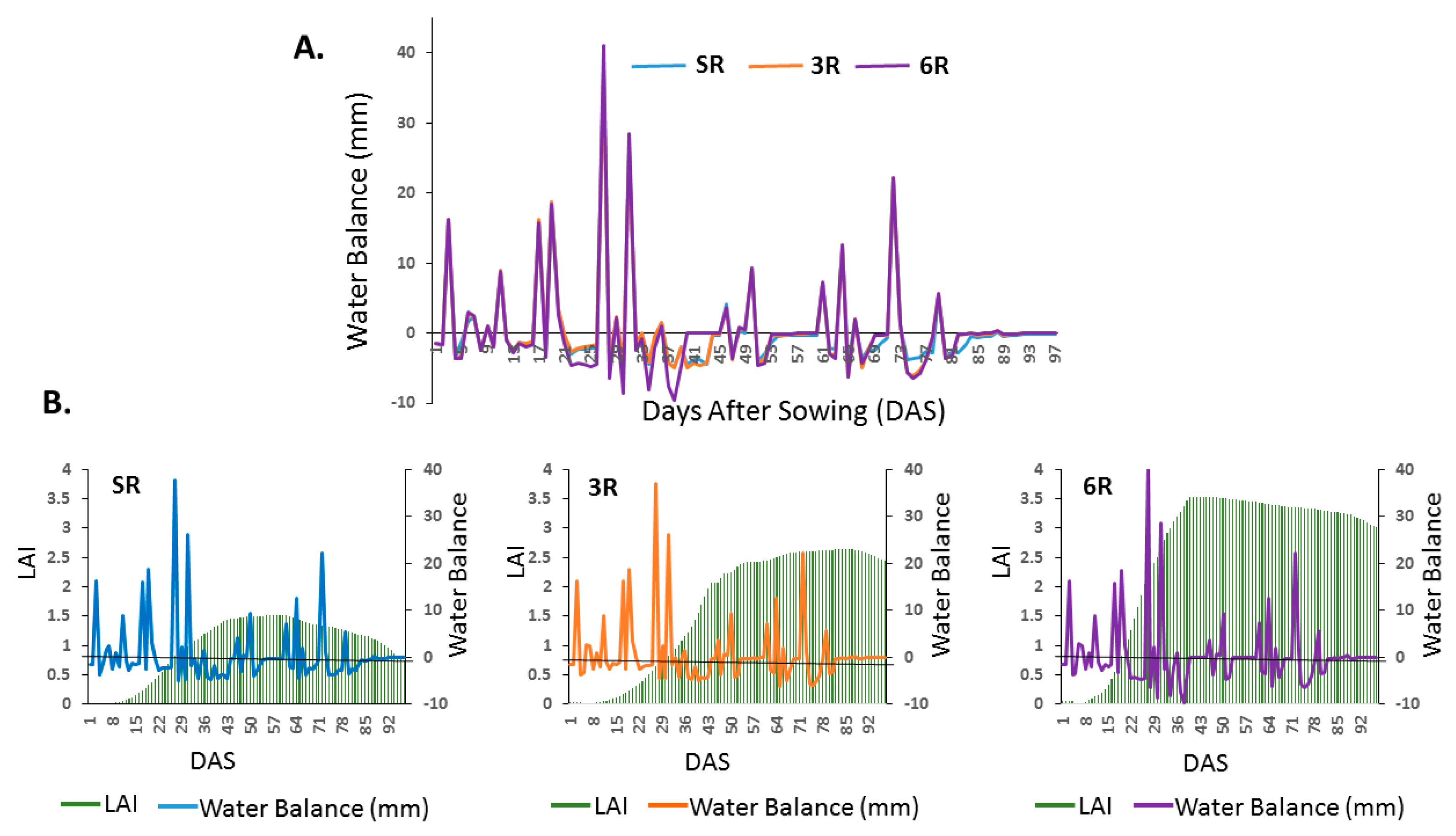High Sowing Densities in Rainfed Common Beans (Phaseolus vulgaris L.) in Mexican Semi-Arid Highlands under Future Climate Change
Abstract
:1. Introduction
2. Materials and Methods
2.1. Study Area
2.2. Cultivars and Sowing Densities
2.3. Precipitation During the Years of Study
2.4. Field Measurements
2.5. ALMANACMEX Model
2.6. Model Parameterization
2.7. Model Evaluation
2.8. Future Climate Change Scenarios
2.9. Model Application to Determine Sowing Density Impact
3. Results and Discussion
3.1. Crop Model Parameterization and Crop Parameters
3.2. Model Evaluation
3.3. Projected Changes in Temperature and Precipitation
3.4. Impact of Sowing Density on Seed Yield
4. Conclusions
Supplementary Materials
Author Contributions
Funding
Acknowledgments
Conflicts of Interest
References
- Lobell, D.B.; Burke, M.B.; Tebaldi, C.; Mastrandrea, M.D.; Falcon, W.P.; Naylor, R.L. Prioritizing climate change adaptation needs for food security in 2030. Science 2008, 319, 607–610. [Google Scholar] [CrossRef]
- Mc Clean, P.E.; Burridge, J.; Beebe, S.; Rao, I.M.; Porch, T.G. Crop improvement in the era of climate change: An integrated, multi-disciplinary approach for common bean (Phaseolus vulgaris). Funct. Plant Biol. 2011, 38, 927–933. [Google Scholar] [CrossRef]
- Battisti, D.S.; Naylor, R.L. Historical warnings of future food insecurity with unprecedented seasonal heat. Science 2009, 323, 240–244. [Google Scholar] [CrossRef] [PubMed] [Green Version]
- Lobell, D.B.; Bänziger, M.; Magorokosho, C.; Vivek, B. Nonlinear heat effects on African maize as evidenced by historical yield trials. Nat. Clim. Chang. 2011, 1, 42–45. [Google Scholar] [CrossRef]
- Stagnari, F.; Maggio, A.; Galieni, A.; Pisante, M. Multiple benefits of legumes for agriculture sustainability: An overview. Chem. Biol. Technol. Agric. 2017, 4, 2. [Google Scholar] [CrossRef] [Green Version]
- Mata, L.J.; Campos, M.; Basso, E.; Compagnucci, R.; Fearnside, P.; Magrin, G.; Villamizar, A. Latin America. In Climate Change 2001: Impacts, Adaptations, and Vulnerability. Contribution of Working Group II to the Thirds Assessment Report of the International Panel on Climate Change; McCarty, J.J., Canzini, O.F., Leary, N.A., Dokken, D.J., White, K.S., Eds.; Cambridge University Press: Cambridge, UK, 2001. [Google Scholar]
- Magrin, G.; Gay García, C.D.; Cruz Choque, J.C.; Giménez, A.R.; Moreno, G.J.; Nagy, C.N.; Villamizar, A. Latin America. In Climate Change 2007: Impacts, Adaptation and Vulnerability. Contribution of Working Group II to the Fourth Assessment Report of the Intergovernmental Panel on Climate Change; Parry, M.L., Canziani, O.F., Palutikof, J.P., van der Linden, P.J., Hanson, C.E., Eds.; Cambridge University Press: Cambridge, UK, 2007. [Google Scholar]
- Beebe, S.E.; Rao, I.M.; Cajiao, C.; Grajales, M. Selection for drought resistance in common bean also improves yield in phosphorus limited and favorable environments. Crop Sci. 2008, 48, 582–592. [Google Scholar] [CrossRef]
- Beebe, S.; Ramirez, J.; Jarvis, A.; Rao, I.M.; Mosquera, G.; Bueno, J.M.; Blair, M.W. Genetic improvement of common beans and the challenges of climate change. In Crop Adaptation to Climate Change; Yadav, S.S., Redden, R., Hatfield, J.L., Lotze-Campen, H., Hall, A., Eds.; John Wiley & Sons, Inc: Hoboken, NJ, USA, 2011. [Google Scholar]
- Beebe, S.; Rao, I.M.; Blair, M.; Acosta, G.J. Phenotyping common beans for adaptation to drought. Front. Physiol. 2013, 35, 1–20. [Google Scholar] [CrossRef] [Green Version]
- Borja-Bravo, M.; Osuna-Ceja, E.S.; Arellano-Arciniega, S.; García-Hernández, R.V.; Martínez-Gamiño, M.Á. Competitividad y eficiencia en la producción de frijol en condiciones de temporal con tecnología tradicional y recomendada. Rev. Fitotec. Mex. 2018, 41, 443–450. [Google Scholar]
- Ricaurte, J.; Clavijo, M.J.A.; Sinclair, T.R.; Rao, I.M. Sowing density effect on common bean leaf area development. Crop Sci. 2016, 56, 1–9. [Google Scholar] [CrossRef] [Green Version]
- Soratto, R.P.; Catuchi, T.A.; Souza, E.D.F.C.D.; Garcia, J.L.N. Plant density and nitrogen fertilization on common bean nutrition and yield. Rev. Caatinga 2017, 30, 670–678. [Google Scholar] [CrossRef]
- Nurk, L.; Graß, R.; Pekrun, C.; Wachendorf, M. Effect of sowing method and weed control on the performance of maize (Zea mays L.) intercropped with climbing beans (Phaseolus vulgaris L.). Agriculture 2017, 7, 51. [Google Scholar] [CrossRef] [Green Version]
- Clavijo, M.J.A.; Ricaurte, J.; Sinclair, T.R.; Rao, I.M.; Beebe, S.E. Influence of plant density and growth habit of common bean on leaf area development and N accumulation. J. Crop Improv. 2019, 33, 1–14. [Google Scholar]
- Osuna-Ceja, E.S.; Reyes-Muro, L.; Padilla-Ramírez, J.S.; Martínez-Gamiño, M.A. Rendimiento de frijol Pinto Saltillo en altas densidades de población bajo temporal. Revista Mexicana De Ciencias Agrícolas 2012, 3, 1389–1400. [Google Scholar] [CrossRef] [Green Version]
- Medina, G.G.; Maciel, P.; Ruíz, C.; Serrano, A.; Silva, S. Estadísticas Climatológicas Básicas Del Estado de Aguascalientes (Período 1961–2003). Available online: https://www.researchgate.net/institution/INIFAP_Instituto_Nacional_de_Investigaciones_Forestales_Agricolas_y_Pecuarias (accessed on 4 March 2020).
- García, E. Climas (Clasificación de Köppen, Modificada por García). Escala1:1000000. CONABIO. México. Available online: http://idegeo.centrogeo.org.mx/layers/geonode%3Aclima1mgw/layer_info_metadata (accessed on 20 July 2018).
- Debouck, D.G. Phaseolus Germplasm Collection in Northwestern Argentina. Available online: https://cgspace.cgiar.org/bitstream/handle/10568/81395/Informe%20Colecta%20Argentina-1986.pdf?sequence=1 (accessed on 5 August 2019).
- Osuna, C.E.S.; Acosta, G.J.A.; Reyes, M.L.; Martínez, G.M.A.; Padilla, R.J.S.; Ventura, R.E.; González, G.E.; Cortés, C.M.A.; Garibaldi, M.F.; Hernández, R.I. Tecnología Para Incrementar la Producción de Frijol de Temporal en el Altiplano Semiárido de México. Instituto Nacional de Investigaciones Forestales, Agrícolas y Pecuarias (INIFAP). Available online: http://biblioteca.inifap.gob.mx:8080/xmlui/bitstream/handle/123456789/1375/783.pdf?sequence=1 (accessed on 4 March 2020).
- Garibaldi, M.F.; Osuna, C.E.S.; Vidal, G.H.; RMartinez, R.E. Sembradora Neumática Para Siembra en Camas. Instituto Nacional de Investigaciones Forestales, Agrícolas y Pecuarias (INIFAP). Available online: http://biblioteca.inifap.gob.mx:8080/jspui/handle/123456789/4457?show=full (accessed on 4 March 2020).
- Baez-González, A.D.; Williams Amber, S.; Kiniry, J. Medición de Parámetros Fisiológicos en Plantas Utilizando el AccuPAR (Ceptómetro LP-80). Instituto Nacional de Investigaciones Forestales, Agrícolas y Pecuarias (INIFAP). Available online: https://www.ars.usda.gov/ARSUserFiles/30980500/Medici%C3%B3n%20de%20Par%C3%A1metros%20en%20Plantas%20Utilizando%20AccuPAR.pdf (accessed on 4 March 2020).
- Baez-González, A.D.; Kiniry, J.R.; Williams, J. ALMANACMEX. Agricultural Land Management Alternatives with Numerical Assessment Criteria Model (ALMANAC) with Mexican Interface. Versión 1.0.18. User’s Manual. Instituto Nacional de Investigaciones Forestales, Agrícolas y Pecuarias (INIFAP). Available online: https://www.ars.usda.gov/ARSUserFiles/30980500/ManualdeUsuarioAlmanacMex(Espanol)August2017.pdf (accessed on 4 March 2020).
- Kiniry, J.R.; Williams, J.R.; Gassman, P.W.; Debaeke, P. A general, process-oriented model for two competing plant species. Trans. Am. Soc. Agric. Eng. 1992, 35, 801–810. [Google Scholar] [CrossRef]
- Williams, J.R.; Jones, C.A.; Dyke, P.T. The EPIC model and its application. In Proceedings of the International Symposium on Minimum Data Sets for Agrotechnology Transfer ICRISAT Center, Patancheru, India, 21–26 March 1983; pp. 111–121. [Google Scholar]
- Hanks, R.J. Yield and water-use relationships: An overview. In Limitations to Efficient Water Use in Crop Production; Taylor, H.M., Jordan, W.R., Sinclair, T.R., Eds.; American Society of Agronomy, Inc.; Crop Science Society of America, Inc.; Soil Science Society of America, Inc.: Madison, WI, USA, 1983; pp. 393–411. [Google Scholar]
- Skrehota, O. Quantitative Structure-Property Relationship Modeling Algorithms, Challenges and IT Solutions. Thesis. Masaryk, University Faculty of Informatics, Czechoslovakia. Available online: https://theses.cz/id/qjv0rf/ (accessed on 6 August 2019).
- Ahuja, L.R.; Ma, L. Parameterization of agricultural system models: Current approaches and future needs. In Agricultural System Models in Field Research and Technology Transfer; Ahuja, L.R., Ma, L., Howell, T.A., Eds.; Lewis Publishers: London, UK, 2002. [Google Scholar]
- Ko, J.; Fox, D. GP-Bayes Filters: Bayesian filtering using Gaussian process prediction and observation models. Auton. Robot. 2009, 27, 75–90. [Google Scholar] [CrossRef] [Green Version]
- Driessen, P.M.; Konijn, N.T. Land-Use Systems Analysis. WAU and Interdisciplinary Research (INRES). Available online: https://research.wur.nl/en/publications/land-use-systems-analysis (accessed on 4 March 2020).
- Monteiro, L.A.; Sentelhas, P.C. Potential and actual sugarcane yields in southern Brazil as a function of climate conditions and crop management. Sugar Tech 2014, 16, 264–276. [Google Scholar] [CrossRef]
- Odongo, V.O.; Onyando, J.O.; Mutua, B.M.; Becht, R. Sensitivity analysis and calibration of the modified universal soil loss equation (MUSLE) for the upper Malewa catchment, Kenya. Int. J. Sediment Res. 2013, 28, 368–383. [Google Scholar] [CrossRef]
- Baez-Gonzalez, A.D.; Kiniry, J.R.; Ramirez, J.S.P.; Garcia, G.M.; Gonzalez, J.L.R.; Ceja, E.S.O. Parameterization of ALMANAC crop simulation model for non-irrigated dry bean in semi-arid temperate areas in Mexico. Interciencia 2015, 40, 185–189. [Google Scholar]
- Arnold, J.G.; Moriasi, D.N.; Gassman, P.W.; Abbaspour, K.C.; White, M.J.; Srinivasan, R.; Santhi, C.; Harmel, R.D.; Van Griensven, A.; Van Liew, M.W.; et al. SWAT: Model use, calibration, and validation. Trans. ASABE 2012, 55, 1491–1508. [Google Scholar] [CrossRef]
- Wallach, D. Evaluating crop models. In Working with Dynamic Crop Models. Evaluating, Analyzing, Parameterizing and Using Them; Wallach, D., Makowski, D., Jones, J.W., Eds.; Elsevier: Amsterdam, The Netherlands, 2006. [Google Scholar]
- Willmott, C.J.; Ackleson, S.G.; Davis, R.E.; Feddema, J.J.; Klink, K.M.; Legates, D.R.; Rowe, C.M. Statistics for the evaluation and comparison of models. J. Geophys. Res. Ocean. 1985, 90, 8995–9005. [Google Scholar] [CrossRef] [Green Version]
- Soler, C.M.T.; Sentelhas, P.C.; Hoogenboom, G. Application of the CSM-CERES-Maize model for planting date evaluation and yield forecasting for maize grown off-season in a subtropical environment. Eur. J. Agron. 2007, 27, 165–177. [Google Scholar] [CrossRef]
- Walton, D.; Meyerson, J.; Neelin, J.D. Accessing, downloading, and viewing CMIP5 data. Earth Syst. Grid Fed. 2013, 25. [Google Scholar]
- Ruiz-Corral, J.; Medina-García, G.; Rodríguez-Moreno, V.; Sánchez-González, J.; Villavicencio García, R.; Durán Puga, N.; Grageda Grageda, J.; García Romero, G. Regionalizaciόn del cambio climático en México. Revista Mexicana De Ciencias Agrícolas 2017, 13, 2451–2464. [Google Scholar] [CrossRef] [Green Version]
- Knox, J.; Hess, T.; Daccache, A.; Wheeler, T. Climate change impacts on crop productivity in Africa and South Asia. Environ. Res. Lett. 2012, 7, 1–8. [Google Scholar] [CrossRef]
- Jones, P.G.; Thornton, P.K. Generating downscaled weather data from a suite of climate models for agricultural modelling applications. Agric. Syst. 2013, 114, 1–5. [Google Scholar] [CrossRef]
- Baez-Gonzalez, A.D.; Kiniry, J.R.; Meki, M.N.; Williams, J.R.; Alvarez-Cilva, M.; Ramos-Gonzalez, J.L.; Magallanes-Estala, A. Potential impact of future climate change on sugarcane under dryland conditions in Mexico. J. Agron. Crop Sci. 2018, 204, 515–528. [Google Scholar] [CrossRef]
- Jessoe, K.; Manning, D.T.; Taylor, J.E. Climate change and labour allocation in rural Mexico: Evidence from annual fluctuations in weather. Econ. J. 2017, 128, 230–261. [Google Scholar] [CrossRef]
- O’Leary, G.J.; Pramod, K.A.; Calderini, D.F.; Connor, D.J.; Craufurd, P.; Sanford, D.E.; Xue, H.; Jerry, L.; Hatfield, L.H. Challenges and Responses to Ongoing and Projected Climate Change for Dryland Cereal Production Systems throughout the World. Agronomy 2018, 8, 34. [Google Scholar] [CrossRef] [Green Version]
- IPCC. Synthesis Report. In Climate Change 2007. Contribution of Working Groups I, II and III to the Fourth Assessment Report of the Intergovernmental Panel on Climate Change; Pachauri, R.K., Reisinger, A., Eds.; Cambridge University Press: New York, NY, USA, 2007; 103p. [Google Scholar]
- Salih, F.A.; El Hardallou, S.B. The yield performance and proximate analysis of twelve cultivars of faba beans grown at five sites in the Northern region of the Sudan. FABIS Newsl. 1986, 15, 52–55. [Google Scholar]
- Sanchez-Valdez, I.; Acosta-Gallegos, J.A.; Ibarra-Perez, F.J.; Rosales-Serna, R.; Singh, S.P. Registration of Pinto Saltillo common bean. Crop Sci. 2004, 44, 1865–1866. [Google Scholar] [CrossRef]
- Rosales-Serna, R.; Kohashi-Shibata, J.; Acosta-Gallegos, J.A.; Lopez, C.T.; Ortiz-Cereceres, J.; Kelly, J.D. Biomass distribution, maturity acceleration and yield in drought-stressed common bean cultivars. Field Crop. Res. 2004, 85, 203–211. [Google Scholar] [CrossRef]
- Folberth, C.; Yang, H.; Gaiser, T.; Liu, J.; Wang, X.; Williams, J.; Schulin, R. Effects of ecological and conventional agricultural intensification practices on maize yields in sub-Saharan Africa under potential climate change. Environ. Res. Lett. 2014, 9, 044004. [Google Scholar] [CrossRef] [Green Version]
- Basso, B.; Ritchie, J.T. Evapotranspiration in High-Yielding Maize and under Increased Vapor Pressure Deficit in the US Midwest. Agric. Env. Lett. Res. Lett. 2018, 3, 1–6. [Google Scholar] [CrossRef]
- Tedla, Y.R.; Habtamu, Z. Genetic Variability on Morpho-Physiological Traits of Drought Resistance in Small Red Seeded Common Bean (Phaseolus vulgaris L.) Genotypes at Goffa. Ph.D. Thesis, Haramaya University, Haramaya, Ethiopia, 2010. [Google Scholar]
- Sadeghi, A.; Cheghamirza, K.; Dorri, H.R. The study of morphoagronomic traits relationship in common bean (Phaseolus vulgaris L.). Biharean Biol. 2011, 5, 102–108. [Google Scholar]
- Nienhuis, J.; Singh, S.P. Effects of location and plant density on yield and architectural traits in dry beans. Crop Sci. 1985, 25, 579–584. [Google Scholar] [CrossRef]
- Gardiner, T.R.; Craker, L.; Vietor, D. Growth habit and row width effects on leaf area development and light interception of field beans. Can. J. Plant Sci. 1979, 59, 191–199. [Google Scholar] [CrossRef]









| Cultivar | Growth Habit † | Plant Cycle (Days) | Grain Size and Color |
|---|---|---|---|
| Flor de Mayo Bajio | Type III | 85–90 | Small, spotted with light background |
| Pinto Saltillo | Type III | 85–90 | Medium, mottled cream brown |
| Azufrado 2 | Type I | 91–115 | Large, light yellow |
| Plant Densities | ||||||
|---|---|---|---|---|---|---|
| SR | 3R | 6R | ||||
| Cultivar | O | S | O | S | O | S |
| Flor de Mayo Bajio | 1.5 ± 0.2 | 1.6 | 1.5 ± 0.2 | 1.6 | 1.6 ± 0.3 | 1.6 |
| Pinto Saltillo | 1.5 ± 0.3 | 1.8 | 1.9 ± 0.3 | 2.0 | 1.9 ± 0.1 | 2.0 |
| Azufrado 2 | 1.1 ± 0.2 | 1.3 | 0.9 ± 0.2 | 1.3 | 1.7 ± 0.2 | 1.8 |
| Crop Parameter | |||||||||
|---|---|---|---|---|---|---|---|---|---|
| Biomass–energy ratio (g MJ−1 m−2) | 25.0 | ||||||||
| Optimal Temperature for Plant Growth (°C) | 30.0 | ||||||||
| Minimum Temperature for Plant Growth (°C) | 8.0 | ||||||||
| Maximum Crop Height (m) | 0.50 | ||||||||
| Maximum Root Depth (m) | 0.60 | ||||||||
| Dry Matter Decline Rate Index | 0.10 | ||||||||
| Harvest Index | 0.36 | ||||||||
| PINTO SALTILLO | FLOR DE MAYO BAJIO | AZUFRADO 2 | |||||||
| SR | 3R | 6R | SR | 3R | 6R | SR | 3R | 6R | |
| Maximum Leaf Area Index (LAI) | 1.8 | 3.5 | 3.5 | 2.0 | 5.0 | 5.0 | 2.0 | 4.2 | 5.0 |
| Fraction of Season When LAI Starts to Decline | 0.75 | 0.77 | 0.77 | 0.77 | 0.78 | 0.80 | 0.60 | 0.77 | 0.77 |
| Light Extinction Coefficient for Beer’s Law | 0.33 | 0.41 | 0.47 | 0.33 | 0.41 | 0.47 | 0.30 | 0.35 | 0.55 |
| First Point on Optimal LAI Curve * | 10; 25 | 15; 10 | 10; 15 | 15; 15 | 15; 10 | 15; 10 | 15; 15 | 20; 10 | 15; 15 |
| Second Point on Optimal LAI Curve * | 40; 99 | 55; 70 | 50; 96 | 50; 80 | 55; 70 | 55; 70 | 42; 91 | 52; 8 | 42; 95 |
| Potential Heat Units (°C) | 1200 | 1100 | 1600 | ||||||
| Data Variable | Cultivars | |||||
|---|---|---|---|---|---|---|
| Flor de Mayo Bajio (III) | Pinto Saltillo (III) | Azufrado 2 (I) | ||||
| Observed Yield | Simulated Yield | Observed Yield | Simulated Yield | Observed Yield | Simulated Yield | |
| Mean | 1.5 | 1.6 | 1.8 | 1.9 | 1.3 | 1.5 |
| Variance | 0.4 | 0.3 | 0.6 | 0.4 | 0.5 | 0.4 |
| Observations | 12 | 12 | 12 | 12 | 12 | 12 |
| Pearson Correlation | 0.94 | 0.91 | 0.86 | |||
| Degrees of Freedom | 11 | 11 | 11 | |||
| t Statistics | 1.42 | 1.08 | 1.99 | |||
| P (T ≤ 1) Two-Tail | 0.18 | 0.31 | 0.07 | |||
| t Critical Two-Tail | 2.20 | 2.20 | 2.20 | |||
| Crop Cultivar | |||||
|---|---|---|---|---|---|
| Site | Climatic Scenario | Sowing Density | Flor de Mayo Bajio ‡ | Pinto Saltillo ‡ | Azufrado 2 ¥ |
| Seed Yield Increments (%) | |||||
| Pabellon de Arteaga | |||||
| RCP4.5 | 3R | 1 | 11 | 2 | |
| 6R | 1 | 13 | 64 | ||
| RCP8.5 | 3R | 2 | 8 | 0 | |
| 6R | 2 | 15 | 63 | ||
| Sandovales | |||||
| RCP4.5 | 3R | 2 | 10 | 0 | |
| 6R | 1 | 16 | 60 | ||
| RCP8.5 | 3R | 4 | 9 | 0 | |
| 6R | 4 | 16 | 61 | ||
© 2020 by the authors. Licensee MDPI, Basel, Switzerland. This article is an open access article distributed under the terms and conditions of the Creative Commons Attribution (CC BY) license (http://creativecommons.org/licenses/by/4.0/).
Share and Cite
Baez-Gonzalez, A.D.; Fajardo-Díaz, R.; Garcia-Romero, G.; Osuna-Ceja, E.; Kiniry, J.R.; Meki, M.N. High Sowing Densities in Rainfed Common Beans (Phaseolus vulgaris L.) in Mexican Semi-Arid Highlands under Future Climate Change. Agronomy 2020, 10, 442. https://doi.org/10.3390/agronomy10030442
Baez-Gonzalez AD, Fajardo-Díaz R, Garcia-Romero G, Osuna-Ceja E, Kiniry JR, Meki MN. High Sowing Densities in Rainfed Common Beans (Phaseolus vulgaris L.) in Mexican Semi-Arid Highlands under Future Climate Change. Agronomy. 2020; 10(3):442. https://doi.org/10.3390/agronomy10030442
Chicago/Turabian StyleBaez-Gonzalez, Alma Delia, Ricardo Fajardo-Díaz, Giovanni Garcia-Romero, Esteban Osuna-Ceja, James R. Kiniry, and Manyowa N. Meki. 2020. "High Sowing Densities in Rainfed Common Beans (Phaseolus vulgaris L.) in Mexican Semi-Arid Highlands under Future Climate Change" Agronomy 10, no. 3: 442. https://doi.org/10.3390/agronomy10030442





